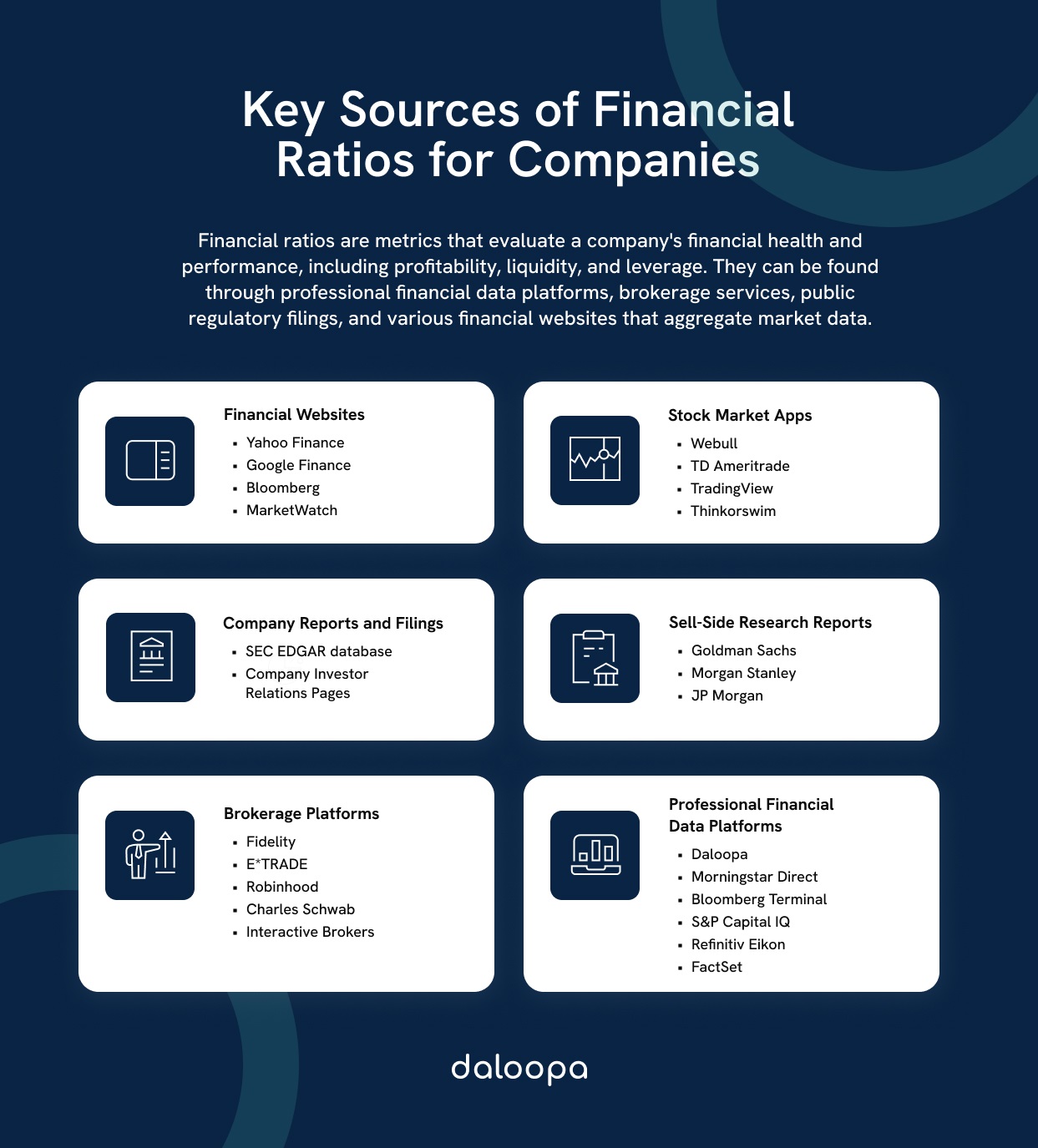For investors and business leaders alike, understanding where to find financial ratios for companies is crucial for making informed decisions. These ratios can typically be found in a company’s financial statements, which include the income statement, balance sheet, and cash flow statement. By analyzing these documents, we can understand a company’s profitability, liquidity, and overall financial health.
Annual reports and official filings like 10-K reports are excellent sources for detailed financial information. Many corporations provide these filings through their websites or via regulatory authority websites such as those of the SEC. They offer a comprehensive view of various financial ratios that highlight different aspects of business performance, including liquidity ratios and investment measures.
For those who prefer a more convenient approach, financial data services like Bloomberg, Yahoo Finance, or Google Finance can offer a streamlined way to access financial ratios for public companies. These platforms aggregate extensive financial data, making it easier for us to compare similar companies and assess their relative strengths and weaknesses.
Key Takeaways
- Financial ratios are key insights from a company’s financial statements that can help us assess its financial health and performance.
- Corporate websites and regulatory authority websites provide detailed reports that we can use to verify and analyze a company’s financial ratios.
- Online financial platforms offer convenient access to financial ratios enabling us to quickly compare and evaluate multiple companies.
The Role of Ratio Analysis in Financial Health
Financial ratios are key tools for assessing a company’s performance by analyzing its financial statements, such as the balance sheet, income statement, and cash flow statement. They provide insights into a company’s financial health, enabling investors and managers to make informed decisions.
Ratio analysis plays an integral role in evaluating a company’s financial health. By examining relationships between different financial statement items, we can identify strengths and weaknesses. Ratios such as liquidity, profitability, and solvency indicate how well a company can meet short-term obligations, generate profits, and manage debt, respectively.
For instance, the current ratio, calculated by dividing current assets by current liabilities, helps us assess liquidity. In most cases, a higher ratio often means better financial stability. Profit margins, on the other hand, shed light on how efficiently a company is turning sales into actual profit. These ratios are valuable for comparing performance over time or against industry benchmarks.
One ratio doesn’t always give the full picture of a company’s health. Combining various financial ratios and looking beyond individual metrics helps us better understand the broader financial landscape.
For example, a company may have a strong current ratio, indicating good short-term liquidity, but if its debt-to-equity ratio is also high, this could signal potential risk in its capital structure. By analyzing both ratios together, we can assess whether the company’s ability to meet short-term obligations is overshadowed by a reliance on debt financing.
Another example is the use of the Altman Z-score which combines several financial ratios to predict the likelihood of bankruptcy. A Z-score above 3 indicates a company is financially healthy, while a score below 1.8 suggests potential distress.
Accessing Company Financial Information
Accessing company financial information involves checking various sources to obtain financial data. Accurate information can be found through public disclosures, annual reports, and on websites designed for investor relations.
Public Disclosures and the SEC
Publicly traded companies are required to disclose financial information through the Securities and Exchange Commission (SEC). These filings, such as 10-K and 10-Q reports, offer comprehensive details about a company’s financial health. By visiting the SEC’s EDGAR database, we can access various financial statements, including income statements and balance sheets. The SEC ensures that these documents provide transparency for investors, helping us make informed decisions. Analyzing these reports can reveal insights into a company’s profitability, liquidity, and risk factors associated with its operations.
Annual and Quarterly Reports
Annual and quarterly reports are vital for understanding a company’s performance over time. These reports highlight financial ratios, operating results, and future outlooks. Through the examination of financial measures such as liquidity ratios or profitability ratios, investors can assess a company’s financial strength and potential vulnerabilities. Often available on company websites and through platforms like the EDGAR database, these documents are indispensable for a deeper evaluation of a company’s fiscal environment. They disclose essential information that helps us analyze stock value and potential returns.
Investor Relations Websites
Investor relations websites offer a direct line to up-to-date financial data and strategic insights. These sites typically host a range of resources that include earnings call recordings, presentation slides, and press releases about financial performance. They are tailored to meet investor needs by providing access to historical financial data and interactive tools that facilitate in-depth analysis. Engaging with investor relations materials allows us to stay informed about operational changes and strategic initiatives that could impact overall financial performance. This access can be crucial when evaluating investment opportunities or when conducting specific financial analyses.

Finding Financial Ratios for Companies
Finding accurate financial ratios allows analysts to assess company performance and make informed investment decisions. Let’s explore various resources where these ratios can be obtained and how they are presented.
Financial Statements and Reports
Companies release financial statements such as balance sheets, income statements, and cash flow statements annually or quarterly. These documents provide the raw data needed to calculate financial ratios, including profitability, liquidity, and solvency ratios.
Investors can access these statements on the company’s official website, often under an investor relations section. Analyzing these documents allows us to assess how efficiently a company is operating and managing its finances, crucial for evaluating its financial health.
Company Websites and Investor Relations
Most companies have dedicated sections on their websites aimed at investors. These investor relations sections frequently include comprehensive financial information, such as annual reports, quarterly earnings, and presentations.
Such resources often highlight key financial ratios directly, saving time in calculations. Monitoring these sections ensures we receive the latest financial data and insights into corporate strategy, aiding in the evaluation of financial health and future prospects.
Financial Databases and Platforms
Numerous financial databases and platforms offer easy access to a wide range of financial ratios. Platforms like Bloomberg, Reuters, and Morningstar provide detailed company analysis, including profitability and valuation metrics. These services allow comparisons between companies within the same industry, helping to identify outperformers.
Platforms such as Reuters and Bloomberg are ideal for deep financial analysis. They offer basic financial ratios and also integrate proprietary analytics, predictive models, and customizable screens allowing professionals to assess a company’s financial health from multiple angles. Daloopa further automates the sourcing of key financial data, providing accuracy and efficiency for investment professionals. This automation allows users to quickly access complete, up-to-date financial information, bypassing manual data entry and enabling better, faster decision-making.
Morningstar, Yahoo Finance, and Google Finance are more appropriate for quick reference or casual research. They offer access to key ratios such as the price-to-earnings (P/E) ratio, debt-to-equity ratio, and return on equity (ROE), but often lack the depth and analytical tools available on premium platforms.
Others like FactSet and Capital IQ provide highly tailored financial models, company insights, and analytics, including unique ratios and metrics not readily available on public platforms. They are particularly useful for institutions conducting rigorous financial modeling, M&A analysis, or equity research.
Industry Reports and Publications
Industry reports provide essential context for understanding how a company performs relative to its peers. These reports often include aggregated financial data and sector-specific ratios.
Publications such as those from Deloitte or PwC offer industry insights and benchmarks that help us evaluate a company’s performance against industry standards. This context aids in identifying strengths and weaknesses compared to other market players.
Financial News and Analysis Websites
Websites like Yahoo Finance, MarketWatch, and CNBC offer accessible financial ratio summaries and analyses. These platforms aggregate data from various sources, providing a quick overview of a company’s financial standing.
For ongoing updates and market insights, these sites are invaluable. Staying informed about financial news allows us to quickly respond to market changes and adjust strategies as needed.
Academic and Professional Journals
Academic journals and professional publications delve into financial ratios’ theoretical and practical applications. Journals often contain peer-reviewed articles analyzing financial data, providing insights into the latest trends and methodologies.
Research findings in these publications enhance our understanding of financial ratio dynamics, which can be useful for both academic pursuits and practical investment applications. Engaging with this material enriches our knowledge of financial ratio implications.
Interpreting Ratios for Investment Decisions
In evaluating financial ratios, we gain insights into a company’s performance. Comparing ratios across companies helps us identify competitive strengths and weaknesses while assessing ratios for long-term investment uncovers potential growth or risks.
Comparing Ratios Across Companies and Industries
In investment decisions, we must compare financial ratios across companies within the same industry to determine competitiveness. Ratios like Return on Equity (ROE) and Gross Margin Ratio highlight operational efficiency and profitability. For instance, a higher ROE indicates effective utilization of shareholders’ equity, while a strong gross margin shows efficient cost control.
Industry norms are crucial. By knowing industry standards, we gauge whether a company’s performance surpasses or lags behind peers. For example, tech companies typically have high ROEs, whereas those in manufacturing may show larger gross margins due to different cost structures.
Long-term Debt is another consideration. Comparing debt ratios across similar firms aids understanding of financial leverage and risk exposure. It is essential to note whether a company’s debt levels align with industry expectations, as excessive debt may signal potential financial distress or limit future growth opportunities.
Assessing Long-Term Investment Potential
Ratios such as Book Value per Share help us evaluate long-term investment potential. They provide insight into the net asset value available to shareholders. A stable or increasing book value suggests a solid financial foundation, appealing to long-term investors.
Moreover, examining the company’s debt ratios reveals its ability to handle obligations over time. A manageable level of long-term debt signifies sustainability and growth potential.
The Gross Margin Ratio offers insight into how well the company controls costs, which is vital for assessing profitability trends. Consistent or rising margins are indicators of strong management practices and effective cost strategies, paving the way for potential long-term success.
Finding Financial Ratios for Comprehensive Analysis
Financial ratios are vital for evaluating a company’s financial health, whether you’re an investor, business leader, or analyst. From corporate financial statements and regulatory filings to online platforms and proprietary databases, there are numerous resources available to access these ratios. While platforms like Bloomberg or FactSet offer deep analysis and proprietary tools for professionals, services like Yahoo Finance provide a quick reference for everyday users. With the right tools, we can accurately assess company performance, benchmark against industry standards, and make more informed investment decisions.
For those looking to upgrade their financial data analysis, consider partnering with Daloopa so you can get complete and accurate financial data as soon as it is released. Manual sourcing can be time-consuming and error-prone, but with Daloopa it is automatic so you can focus on more important tasks.



